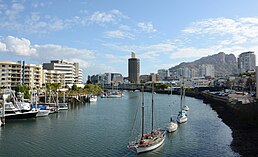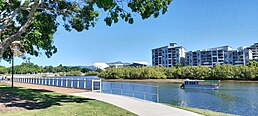
A | B | C | D | E | F | G | H | CH | I | J | K | L | M | N | O | P | Q | R | S | T | U | V | W | X | Y | Z | 0 | 1 | 2 | 3 | 4 | 5 | 6 | 7 | 8 | 9
| Townsville Queensland | |||||||||
|---|---|---|---|---|---|---|---|---|---|
Former Queen's Hotel on The Strand Townsville waterfront with North Queensland Stadium in the background | |||||||||
| Coordinates | 19°15′S 146°49′E / 19.250°S 146.817°E | ||||||||
| Population | 179,011 (2021 census)[1] | ||||||||
| • Density | 258.201/km2 (668.74/sq mi) | ||||||||
| Established | 1865 | ||||||||
| Postcode(s) | 4810 | ||||||||
| Elevation | 15 m (49 ft) | ||||||||
| Area | 693.3 km2 (267.7 sq mi)[2] (2021 urban) | ||||||||
| Time zone | AEST (UTC+10) | ||||||||
| Location |
| ||||||||
| LGA(s) | City of Townsville | ||||||||
| County | Elphinstone | ||||||||
| State electorate(s) | |||||||||
| Federal division(s) | |||||||||
| |||||||||
Townsville is a city on the north-eastern coast of Queensland, Australia. With a population of 179,011 as of the 2021 census,[1] it is the largest settlement in North Queensland and Northern Australia (specifically, the parts of Australia north of the Sunshine Coast). It is unofficially considered the capital of North Queensland. Townsville hosts a significant number of governmental, community and major business administrative offices for the northern half of the state.[4]
Part of the larger local government area of the City of Townsville,[5] it is in the dry tropics region of Queensland, adjacent to the central section of the Great Barrier Reef.[6] The city is also a major industrial centre, home to one of the world's largest zinc refineries, a nickel refinery and many other similar activities. As of December 2020, $30M operations to expand the Port of Townsville are underway, which involve channel widening and installation of a 70-tonne Liebherr Super Post Panamax Ship-to-Shore crane, to allow much larger cargo and passenger ships to utilise the port.[7][8] It is an increasingly important port due to its proximity to Asia and major trading partners such as China.
Dominant sectors of its diverse economy include defence, administration, health and education, manufacturing, energy, transport and logistics.[9][10] The city is a national hub for renewable energy, in green hydrogen and polysilicon, as well as the centre of CopperString 2032 being Australia's largest renewable transmission project.[11][12][13] Townsville is Australia's 'fortress city', home to a large part of the strategic capability of the ADF, offering essential services including maintenance and supply chains including one of the largest military bases in Australia[14] as well as a Royal Australian Air Force (RAAF) base that can accommodate most military aircraft in service. Townsville is the industrial heart of northern Australia with a GRP of $15.1 billion in 2023.[15] The city is served by Townsville Airport and the Port of Townsville, the largest general freight and container port in northern Australia.[16]
Popular attractions include "The Strand", a long tropical beach and garden strip; Riverway, a riverfront parkland attraction located on the banks of Ross River; Reef HQ, a large tropical aquarium holding many of the Great Barrier Reef's native flora and fauna; the Museum of Tropical Queensland, built around a display of relics from the sunken British warship HMS Pandora; Castle Hill or as it was originally known Cootharinga, the most prominent landmark of the area and a popular place for exercise; The Townsville Sports Reserve; and Magnetic Island, a large neighbouring island, the vast majority of which is national park.
History
Early history
Aboriginal peoples such as the Wulgurukaba, Bindal, Girrugubba, Warakamai and Nawagi originally inhabited the Townsville area.[17][18] The Wulgurukaba claim to be the traditional owners of the Townsville city area; the Bindal had a claim struck out by the Federal Court of Australia in 2005.[19]
James Cook visited the Townsville region on his first voyage to Australia in 1770, but did not actually land there. Cook named nearby Cape Cleveland, Cleveland Bay and Magnetic(al) Island.[20] In 1819, Captain Phillip Parker King and botanist Alan Cunningham were the first Europeans to record a local landing.[20]
In 1846, James Morrill was shipwrecked from the Peruvian, living in the Townsville area among the Bindal people for 17 years before deciding to return to British society when the frontier of colonisation came to the region.[21][20]
In 1860, George Elphinstone Dalrymple led a maritime expedition to the region from Brisbane. The expedition sailed to Cleveland Bay, finding a very numerous Aboriginal population. They landed on the shore near to where the modern city of Townsville now stands and met with a number of Aboriginal people, giving them biscuit and tobacco. The Aboriginal people started to touch and feel all the expedition members, and began "smacking their lips", which Dalrymple interpreted as an indication that they wanted to eat them. Another group of Aboriginal people came down, attacking them with a shower of stones and spears. Dalrymple and his men "were necessitated" to fire upon them, "repulsing them with loss." They landed again near to Cape Pallarenda to obtain surveys from the hilltops but decided to descend to their awaiting dinghies as they noticed residents of three Aboriginal camps below were moving in their direction. These people were yelling and dancing "in a very hostile manner" and Dalrymple felt obliged to fire upon them. Dalrymple's group then made an "orderly retreat" to the dinghies halting at intervals to fire upon those throwing spears. The crew which had remained upon the Spitfire had seen about eight armed Aboriginal men in canoes approaching them from nearby Magnetic Island in an apparent attempt to board the ship. They were repulsed by a discharge of the brass gun.[22]
Establishment
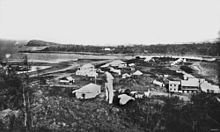
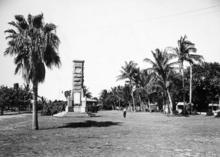
The Burdekin River's seasonal flooding made the establishment of a seaport north of the river essential to the nascent inland cattle industry.[23] John Melton Black of Woodstock Station, an employee of Sydney entrepreneur and businessman Robert Towns, dispatched Andrew Ball, Mark Watt Reid and a detachment of 8 troopers of the Native Police under the command of John Marlow to search for a suitable site.[20] Ball's party reached the Ross Creek in April 1864 and established a camp below the rocky spur of Melton Hill, near the present Customs House on The Strand.[20]
Edward Kennedy, a Native Police officer accompanying the group, recalled how his "boys" (the Aboriginal troopers) chased four or five local tribesmen into the ocean. Kennedy then stated that he "left the "boys" in the water, pumping lead and hurling derisive cries at them, neither of which seemed to reach their mark". A member of the expedition who was from a town in the south accidentally shot dead an elderly Aboriginal man. He said that he thought he was being stalked by an alligator. On the return journey to Port Denison, the group "dispersed" another Aboriginal camp in reprisal for the killing of a shepherd. After the fighting, the "boys" rounded up around 12 women and each took turns based on their rank in selecting one. "In five minutes, each had chosen their spouse and the ceremony was complete."[24]
The next group of colonists, led by W. A. Ross, arrived at Cleveland Bay from Woodstock Station on 5 November of that year. In 1866 Robert Towns visited for three days, his first and only visit. He agreed to provide ongoing financial assistance to the new settlement and Townsville was named in his honour.[20] Townsville was declared a municipality in February 1866, with John Melton Black elected as its first Mayor.[20] Townsville developed rapidly as the major port and service centre for the Cape River, Gilbert, Ravenswood, Etheridge and Charters Towers goldfields.[23] Regional pastoral and sugar industries also expanded and flourished.
Importation of South Sea Islander labour
On 8 July 1866 Robert Towns imported the first boatload of South Sea Islanders into Townsville to labour on the cane and cotton farms. They numbered 56 and arrived on the Blue Bell which had brought them from the Loyalty Islands and the New Hebrides.[25] Charges were made against Henry Ross Lewin, the recruiter for Robert Towns, that some of the Islanders had been kidnapped to work on the plantations.[26] In 1867, a magisterial enquiry was set up into the death of an Islander working on one of Towns' plantations. A pharmacist attending was of the opinion the death was caused by a lack of proper nourishment, the Islanders receiving only cornmeal for food. Other evidence was given by employees of the plantation company who claimed the labourers were treated well and a verdict of death by natural causes was declared.[27]
Turn of the century
Townsville's population was 4,000 people in 1882 and grew to 13,000 by 1891.[20] In 1901 Lord Hopetoun made a goodwill tour of northern Australia and accepted an invitation to officially open Townsville's town hall, occasioning the first ever vice-regal ceremonial unfurling of the Australian national flag.[23] With Brisbane, in 1902 Townsville was proclaimed a City under the Local Authorities Act.[28]
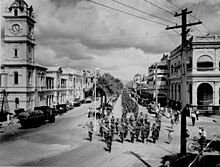
The foundation stone of the Townsville Cenotaph was laid in Strand Park on 19 July 1923.[29] It was unveiled on 25 April 1924 (ANZAC Day) by the Queensland Governor, Sir Matthew Nathan.[30][31]
Townsville/Thuringowa
The rural land surrounding the city was initially managed by the Thuringowa Road Board, which eventually became the Shire of Thuringowa. The shire ceded land several times to support Townsville's expansion.[32] In 1986 the Shire became incorporated as a city, governed by the Thuringowa City Council. The cities of Townsville and Thuringowa were amalgamated into the "new" Townsville City Council in March 2008, as part of the Queensland state government's reform program.[32]
Japanese influence
In 1896, Japan established its first Australian consulate in Townsville, primarily to serve some 4,000 Japanese workers who migrated to work in the sugar cane, turtle, trochus, beche de mer, and pearling industries.[33][34] With the introduction of the White Australia policy, the demand for Japanese workers decreased, causing the consulate to finally close in 1908.[34]
Second World War

At the beginning of 1942, Townsville had 30,000 inhabitants and between 5,000 and 7,000 of them voluntarily evacuated to other places.[35] During the Second World War, the city was host to more than 50,000, and Townsville Naval Section Base.[36] American and Australian troops and air crew, and it became a major staging point for battles in the South West Pacific. A large United States Armed Forces contingent supported the war effort from seven airfields and other bases around the city and in the region. Many buildings, schools and 177 private houses were commandeered for use by the military.[37] Slit trenches were dug in many places, and 18 concrete air-raid shelters were built, six of them in Flinders Street.[38] The first bombing raid on Rabaul, in Papua New Guinea, on 23 February 1942 was carried out by six B-17s based near Townsville.[citation needed]
Some of the units based in Townsville were:
- No. 3 Fighter Sector RAAF, Wulguru & North Ward
- 1 Wireless Unit, Pimlico & Stuart & Roseneath
- North Eastern Area Command HQ, Townsville, Sturt Street (now the Federation building)
- Castle Hill, Townsville[39] tunnels & bunkers
- Green St. Bunker, West End, Sidney Street West End, Project 81 (now the SES building)
- 96th Engineer Battalion (which mutinied in April 1942.[40])
In July 1942, three small Japanese air raids were conducted against Townsville, which was by then the most important air base in Australia.[41] On 25 July 1942 two Japanese Kawanishi Flying Boats dropped 15 bombs which landed near the mouth of the Ross River, only 370 metres (400 yd) east of oil tanks in the harbour.[42] On 28 July, one Japanese plane dropped eight 230-kilogram (500-pound) bombs near the Garbutt airfield. On 29 July 1942, a single "Emily" Flying Boat dropped one bomb at the Experimental Station of Oonoonba and seven bombs landed in Cleveland Bay where bomb craters are still clearly visible.[43] There were no deaths and structural damage was minimal, as the Japanese missed their intended targets of the railway, the harbour and the airfield and destroyed a palm tree at the Experimental Station of Oonoonba. Although the Japanese aircraft were intercepted on two of the three raids, no Japanese planes were shot down.[44]
1960s and 1970s
In 1961 the University of Queensland established a campus at Pimlico, near Pimlico State High School, later developing a site at Douglas near the Army Barracks, and across the new Nathan Street Bridge. The faculties of Arts, Law, and Education, and several residential colleges, Union, St Mark's, and John Flynn relocated from central Townsville. This was followed by the relocation of St Raphael's college for women. A large modernist building was established. In 1971 Cyclone Althea with flooding slowed progress of infrastructural building, but by 1972 James Cook University was established, with ecru academic gowns, quite different to those of older universities. From 1961, only the first years of studies for Medicine and for Veterinary Sciences were offered in Townsville, but the establishment of a new General Hospital at Mount Louisa provided facilities necessary for the establishment of an independent Medical School.[citation needed]
In 1970, Queen Elizabeth II, Prince Philip, Duke of Edinburgh and Her Royal Highness Princess Anne toured Australia including Queensland.[citation needed] The Queensland tour began on Sunday 12 April when the royal yacht Britannia entered Moreton Bay at Caloundra, sailing into Newstead Wharf. After visiting Brisbane, Longreach and Mount Isa the Royal Family travelled to Mackay.[citation needed] The royal party had a leisurely cruise to Townsville, taking four days to arrive after their departure from Mackay. On the morning of April 20, they were met by The Deputy Mayor of Townsville Mr. T. Aikens, M.L.A. and Mrs Aikens and Mr W.W. Shepherd, Chairman of the Townsville Harbour Board and Mrs Shepherd.[citation needed] The day’s program began with a cavalcade of progress at the Townsville sports reserve. The grounds were filled with crowds and children waving their Australian flag. It was a spectacle for the royal visitors and the local community who came out on the day.[citation needed]
Following lunch on board Britannia, the royal family were driven to the site of Queensland’s newest university, the James Cook University, Townsville campus. In the presence of many dignitaries, HRH Queen Elizabeth II formally granted autonomy to North Queensland’s new educational institution. In 2020, James Cook University celebrated its 50th anniversary with a Treasures exhibition, showcasing 50 collection items from Special Collections, Eddie Koiku Mabo Library, James Cook University, Townsville.
The rare collection item – ‘James Cook University Development: Pimlico to the First Chancellor archival footage, 1960 – 1970’ was one of the Treasures selected for the anniversary year. The 12min film preserved on NQHeritage, the University Library’s Special Collections online repository, shows footage of Her Majesty Queen Elizabeth II arriving at the official ceremony and being introduced to the official party.[45] Their Royal Highnesses first appear in the film at 6:06 minutes.[46]
On Christmas Eve 1971, Tropical Cyclone Althea, a category 4 cyclone, battered the city and Magnetic Island, causing considerable damage.[47]
In 1973, Indigenous activists Eddie and Bonita Mabo established the Black Community School in Townsville, where children could learn their Indigenous culture rather than white culture.[48] Eddie Mabo worked as a gardener at James Cook University in the 1970s and 1980s. It was at the university in 1974 that he first learned of the implications of the terra nullius doctrine which held that he did not legally own the land he believed was his under the traditional land inheritance system of his people.[49][50]
1980s
Buchanan's Hotel in Flinders Street, regarded by architectural historians as Australia's most significant building in the Filigree style, was lost to fire in 1982.[citation needed]
In 1981 a land rights conference was held at James Cook University and Eddie Mabo made a speech to the audience where he explained the land inheritance system on Murray Island. The significance of this in terms of Australian common law doctrine was taken note of by one of the attendees, a lawyer, who suggested there should be a test case to claim land rights through the court system. Mabo decided to take on the Australian Government.[51] Perth-based solicitor Greg McIntyre was at the conference and agreed to take the case; he then recruited barristers Ron Castan and Bryan Keon-Cohen.[52] McIntyre represented Mabo during the hearings.[53] The James Cook University Douglas campus library is now named after Mabo.[54]
1990s
On 3 June 1992, the High Court of Australia ruled in favour of Eddie Mabo in Mabo v Queensland (No 2) recognising native title in Australia for the first time.[55]
In 1993, the New South Wales Rugby League announced that a team from Townsville would be admitted to the expanded, nation-wide competition, and the North Queensland Cowboys made their debut in the 1995 ARL season.
2000–present
In October 2000, a Solomon Islands Peace Agreement was negotiated in Townsville.[56]
In February 2019, Townsville experienced a major flood event, which caused five deaths. Floodwaters damaged approximately 3300 homes and about 1500 homes were rendered uninhabitable.
Urban layout
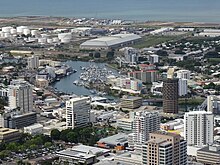
Inner-city high-density development has also created population growth and gentrification of the central business district (CBD). One significant contributor to CBD development was the construction of a new rail passenger terminal and re-siting of the railway workshops,[57] releasing prime real estate which formerly belonged to Queensland Rail for the development of residential units, retail projects and a new performing arts centre. The skyline of Townsville's central business district has undergone dramatic changes over the last few years, with a number of new highrise buildings, both commercial and residential, constructed.[58]
In the short term, much of the urban expansion will continue to the west and the north, in the former City of Thuringowa. The most significant of these is North Shore Estate, a new A$1 billion 5,000-lot housing estate, located close to the Bruce Highway, just north of the Bohle River.[59]
Medium-term city expansion will be focused on two major urban developments that have started in 2017 and 2018. Elliot Springs, a satellite city to the south of Townsville developed by national developer Lendlease Group, is expected to be home to 26,000 people by 2057.[60] Additionally, the Queensland Government announced it will be offering 270 hectares (670 acres) of state-owned land (the former abattoir reserve), just south of the Bohle River, for urban expansion.[61]
Geography

Townsville lies approximately 1,350 kilometres (840 mi) north of Brisbane, and 350 kilometres (220 mi) south of Cairns. It lies on the shores of Cleveland Bay, protected to some degree from the predominantly south-east weather. Cleveland Bay is mostly shallow inshore, with several large beaches and continually shifting sand bars. Magnetic Island lies 8 kilometres (5 mi) offshore, to the north of the city centre. It, together with Castle Hill in the town centre and Mount Stuart to the south of the city, form a large quartz monzonite igneous province.[citation needed]
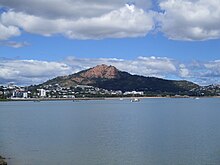
The Ross River flows through the city. Three weirs, fish stocking and dredging of the river in these reaches has resulted in a deep, stable and clean waterway used for many recreational activities such as water skiing, fishing and rowing. Thirty kilometres (19 mi) from the mouth (at the junction of Five Head Creek) is the Ross River Dam, the major water storage for the urban areas.
The historic waterfront on Ross Creek, site of the original wharves and port facilities, has some old buildings mixed with the later modern skyline. However, the central city is dominated by the mass of red granite of Castle Hill, 286 metres (938 ft) high.[62] There is a lookout at the summit giving panoramic views of the city and its suburbs, including Cleveland Bay and Magnetic Island. There are a number of parks scattered throughout the city, including three botanical gardens — Anderson Park, Queens Gardens and The Palmetum.
Climate
| Townsville, Queensland, Australia | ||||||||||||||||||||||||||||||||||||||||||||||||
|---|---|---|---|---|---|---|---|---|---|---|---|---|---|---|---|---|---|---|---|---|---|---|---|---|---|---|---|---|---|---|---|---|---|---|---|---|---|---|---|---|---|---|---|---|---|---|---|---|
| Climate chart (explanation) | ||||||||||||||||||||||||||||||||||||||||||||||||
| ||||||||||||||||||||||||||||||||||||||||||||||||

